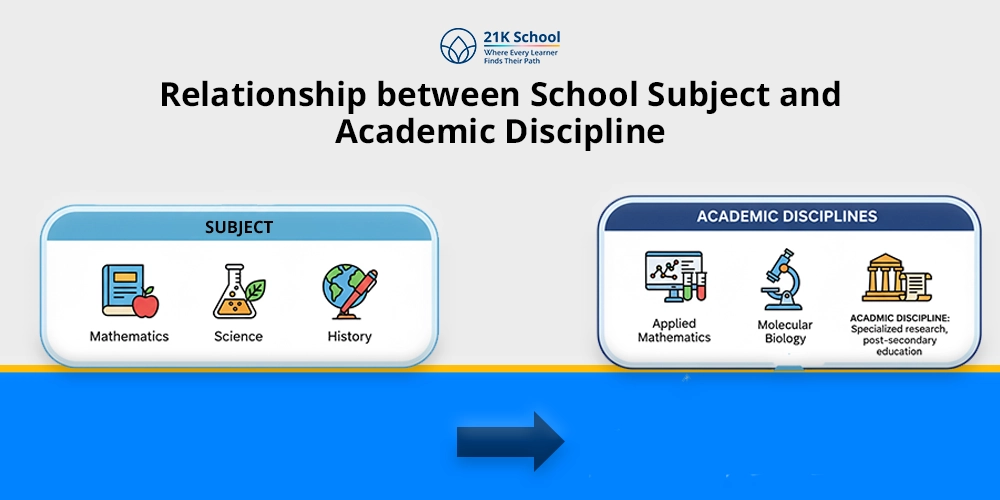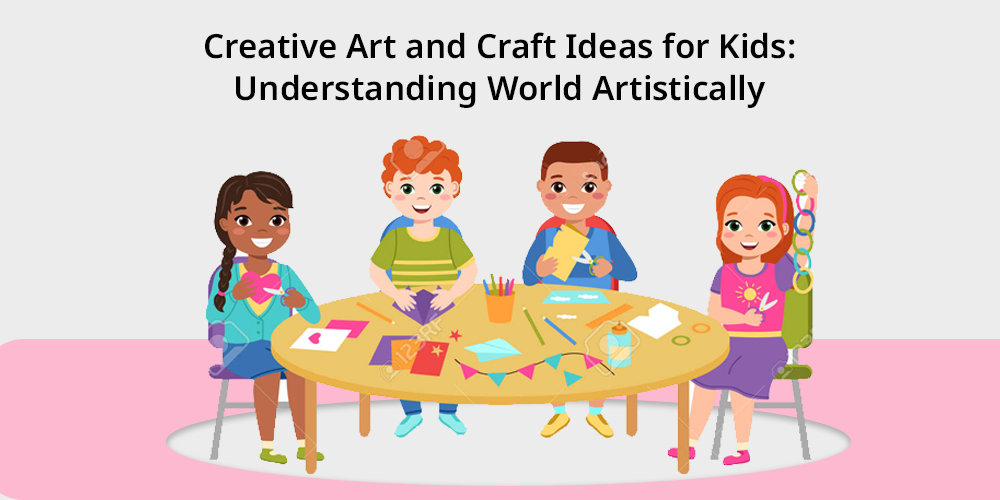
Children have a natural tendency to actively explore everything which surrounds them. Art and craft activities represent the strongest and most fun methods which help children investigate their environment.
The act of creativity provides children with a foundational learning method during which they develop emotionally. Intellectual development, and self-expression are followed by the former one.
Children express their emotions and conceptual thoughts as they work on artistic assignments to enhance self-awareness.
This article studies creative art projects designed for children alongside the most valuable benefits of developing creative thinking skills .
These artistic concepts serve individuals who work with young people or aim to enhance their creative skills.
Contents
10 Creative Art and Craft Ideas for Kids
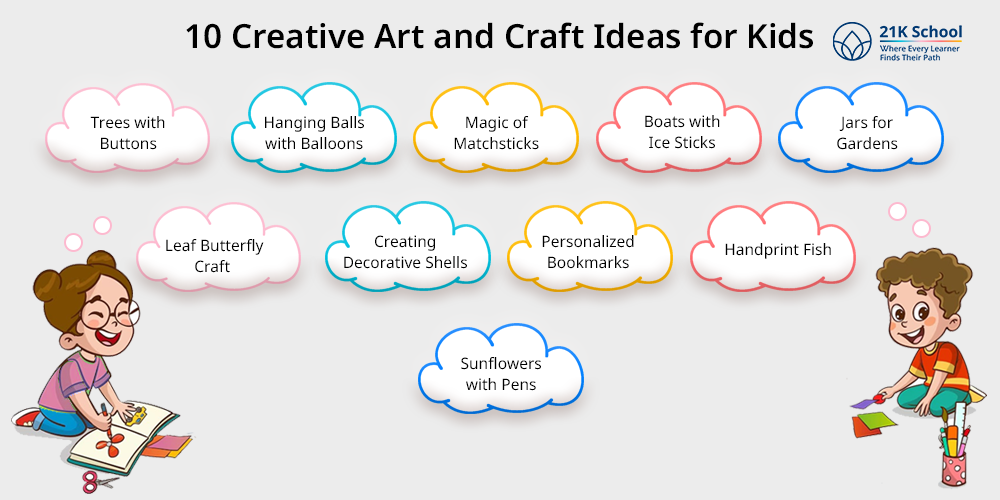
1. Trees with Buttons
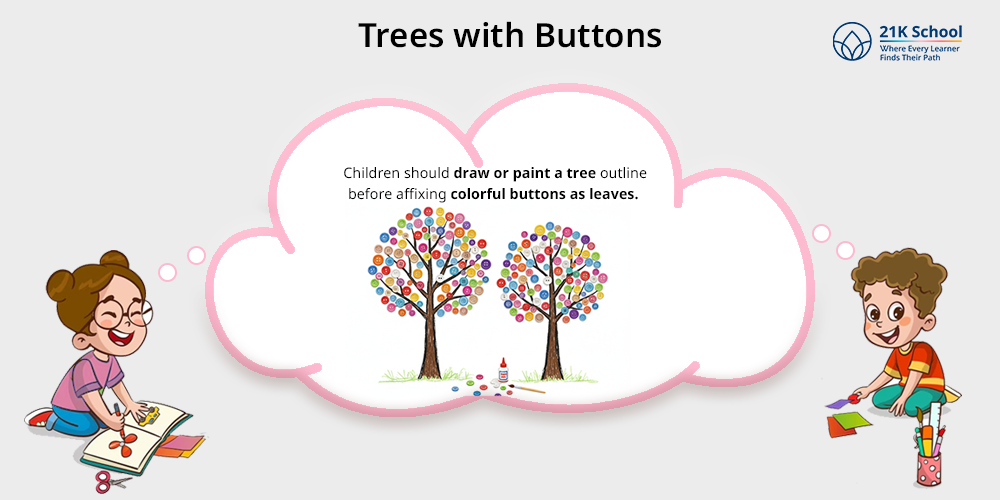
Children should draw or paint a tree outline before affixing colorful buttons as leaves. The challenge offers both natural elements alongside creative development in a simple entertaining format.
Children get exposure to different material textures along with colorful decorative elements and geometric designs through this activity.
They benefit from two advantages by using old buttons while learning about sustainable education .
- Creative Kit: Pencil, marker, paint colours, brown and green paper, glue, scissors, and coloured buttons.
- Steps to Create: Do an outline of a tree trunk with a pencil or marker. Then paint it, or cut out a trunk from the brown paper. Follow up by adding branches with the same papers. Now, finish the procedure by sticking the buttons on the branches.
- Quick Artist Tip: Collect as many buttons of different colours and sizes as you can, to make your tree look lively.
2. Hanging Balls with Balloons
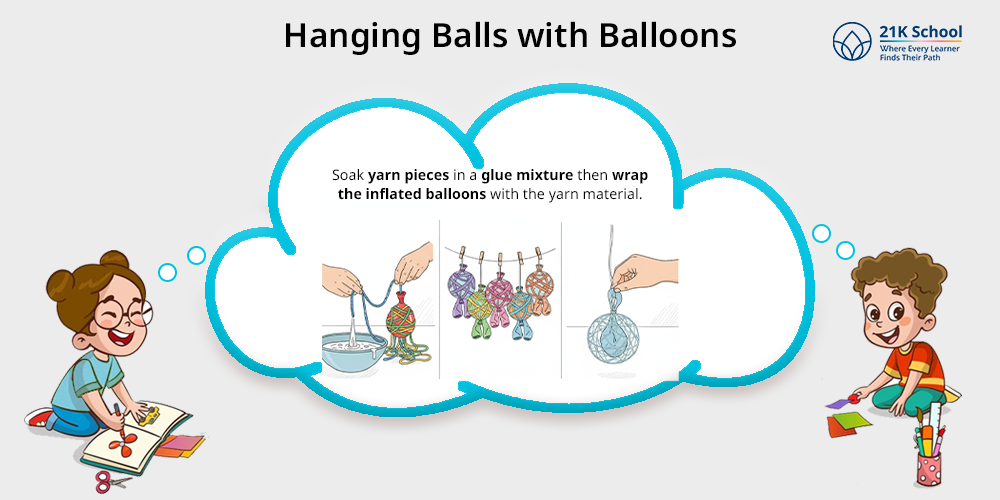
Soak yarn pieces in a glue mixture then wrap the inflated balloons with the yarn material. After the balloon dries you should pull out the balloon while keeping the delicate string ball attached to a thread.
This project both improves patience and hand coordination while giving children a rewarding experience. These decorative items work well as holiday decors.
- Creative Kit: Glue, scissors, balloon, jute thread or yarn, water, bowl, glitter, and paintbrush.
- Steps to Create: Inflate a balloon, dip the thread or yarn in a fevicol-water mix, and start wrapping it around the balloon. As the thread dries up, add paint to it or even glitters for extra shimmer. Now, pop the balloon and cautiously remove it. Your decor is ready.
- Quick Artist Tip: Wrap the thread tightly so that after bursting the balloon, the shape remains intact.
3. Magic of Matchsticks
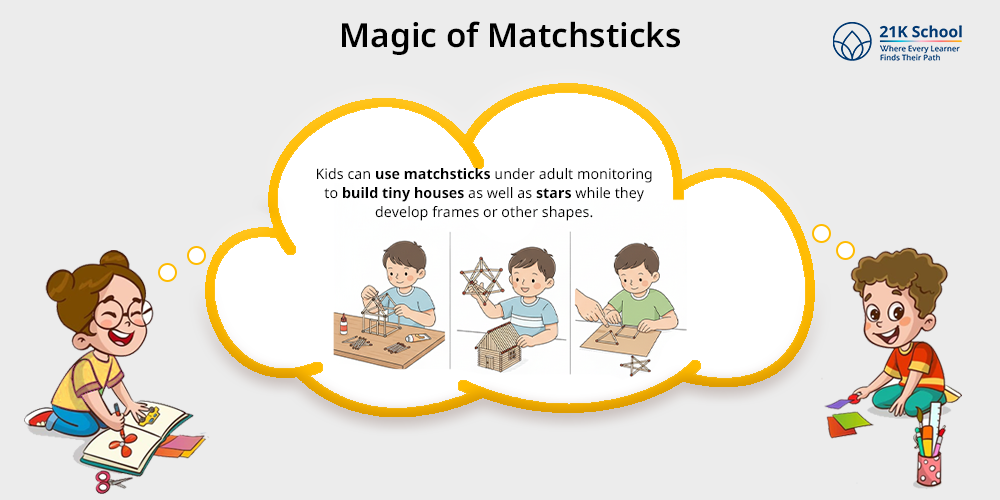
Kids can use matchsticks under adult monitoring to build tiny houses as well as stars while they develop frames or other shapes.
The activity provides basic engineering lessons while teaching children to develop their precision skills.
- Creative Kit: Matchsticks, adhesive (glue), and base (cardboard).
- Steps to Create: Begin by drawing an outer sketch of the frame or house you want to draw. Add matchstick by gluing them to the outers. Now, fill the interiors with proper alignment of the sticks.
- Quick Artist Tip: First apply your hands onto simple geometric shapes or frames before moving on to 3D pictures.
4. Boats with Ice Sticks
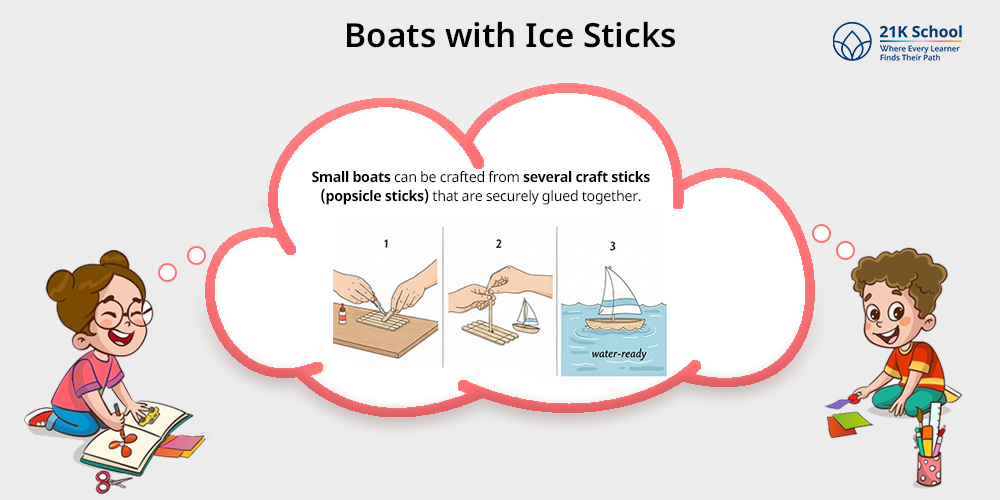
Small boats can be crafted from several craft sticks (popsicle sticks) that are securely glued together. You can make a water-ready sailing ship when you place a paper sail onto it.
The toy enables young children to learn balance and design principles during bathtub or tub water activities.
- Creative Kit: Ice cream sticks or popsicle sticks, glue, paper, scissors, and toothpick.
- Steps to Create: Adhere the sticks along the ends, one on the other. First make the base by sticking the edges horizontally. Now build the body of the boat simultaneously. Add a toothpick mast and then use a paper to sail. Your mini boat is ready!
- Quick Artist Tip: You can add colours on the boat before. Paint the popsicle sticks first for a more vibrant appearance.
5. Jars for Gardens
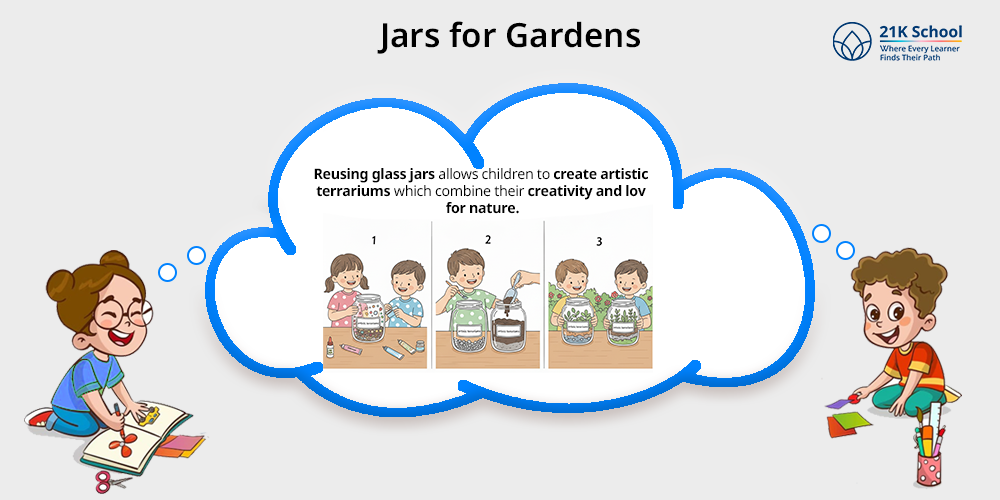
Reusing glass jars allows children to create artistic terrariums which combine their creativity and love for nature. Children should start by adorning their jars with paint or glitter stickers and then place stones in with soil and tiny plants.
The practice creates feelings of accountability along with environmental affection.
Other than that, here is how to raise environmental awareness among young people , especially in today’s generation.
- Creative Kit: Old and empty jars, pebbles, soil, small plants (that require lesser care and water to grow), and paints.
- Steps to Create: Take empty jars and colours to their outsides. Draw flowers or dots as you wish. Add pebbles, stones, and soil before planting.
- Quick Artist Tip: Use a spatula or spoon to add soil in the jars so that it doesn’t spill over their walls.
6. Leaf Butterfly Craft
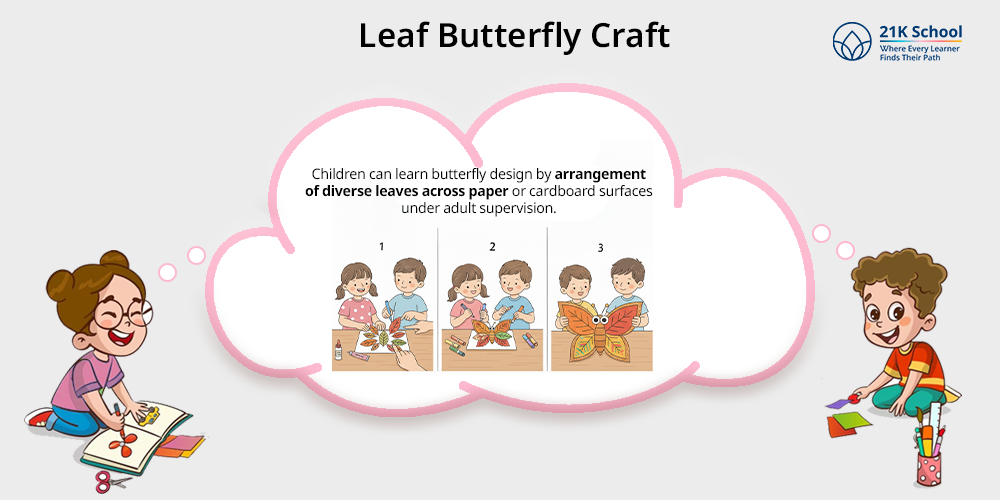
Children can learn butterfly design by arrangement of diverse leaves across paper or cardboard surfaces under adult supervision. Paint your creation with markers followed by decorating wings and googly eyes for splice and color.
Through these activities children learn to recognize how nature displays symmetric designs and variety in the world.
- Creative Kit: Leaves, glue, straw, a stick, paints, and markers.
- Steps to Create: Firstly draw a butterfly’s body and an overall outline. Stick a piece of stick onto the body and two small straws as antennas. Now, take a leaf and paint its one side properly and apply it on the place of its wings. Do the same on both wings. Add eyes with marker and white paint.
- Quick Artist Tip: Add the same paint on the same leaf on the same side for the best outcomes.
7. Creating Decorative Shells
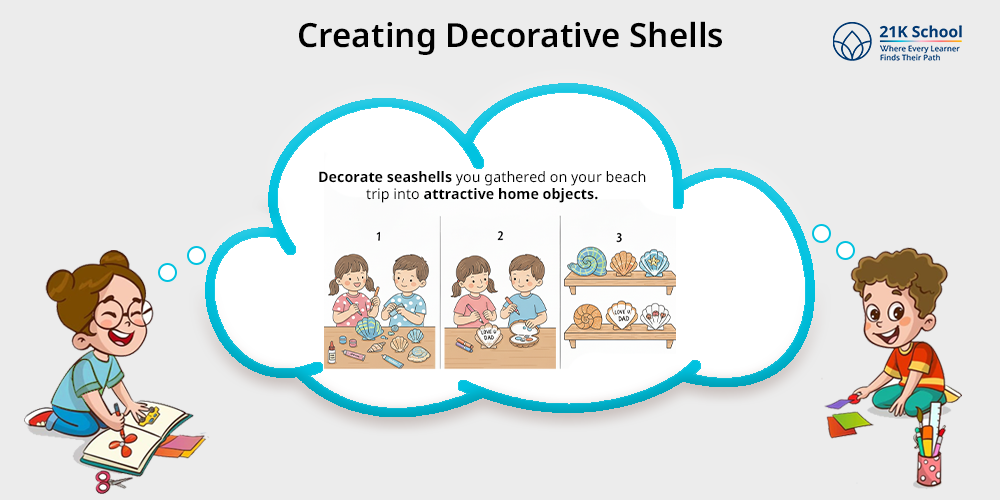
Decorate seashells you gathered on your beach trip into attractive home objects. Add paint, polish, or sparkles to decorate them by including personal messages inside the shells.
The activity enables children to discover ocean creatures and create cherished items for their personal memories.
You can also have a read on memory games for kids to boost brain power. Take a ride on and make your children better than others.
- Creative Kit: Seashells, paint colours, glitters,fevicol, small pebbles or beads.
- Steps to Create: Color the shells with paint and add glitters. Proceed to decorate them by adding small beads or colourful pebbles onto it with the help of glue.
- Quick Artist Tip: You can opt for metallic paint for a shiny finish that gives underwater vibes.
8. Personalized Bookmarks
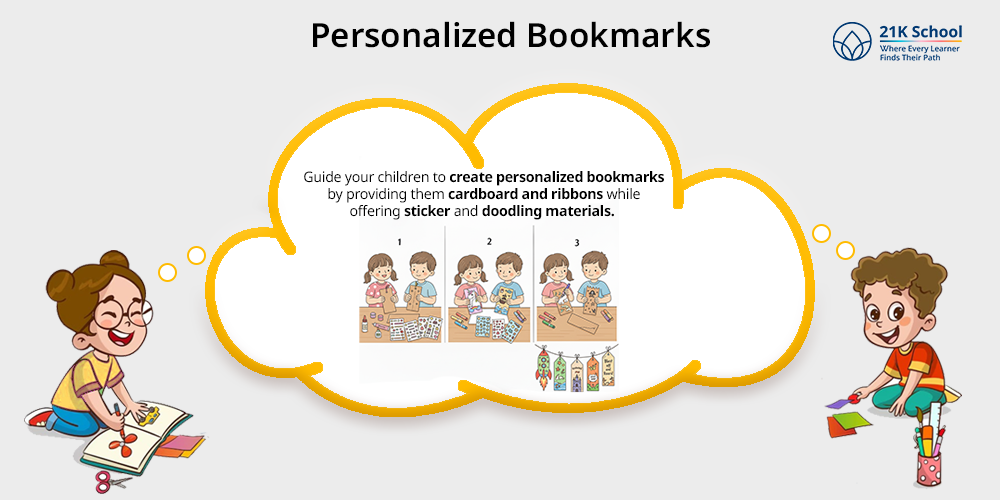
Guide your children to create personalized bookmarks by providing them cardboard and ribbons while offering sticker and doodling materials. The bookmarks can have various themes that combine literary interests with character preferences.
These bookmarks help children deepen their reading experiences while nurturing their creative minds. It will thus develop a reading habit in your child in the long run.
- Creative Kit: Markers, colours, cardstock paper, hole puncher, ribbons or threads.
- Steps to Create: Begin with cutting a rectangular stripe and then make shapes or drawings of your own priority. Write quotes, or use stickers as well. Now, punch a hole on the top-center of the stripe vertically to tie a ribbon in it.
- Quick Artist Tip: Take inspiration from various platforms like pinterest, or instagram for the quotes. Finish by laminating your bookmark for increasing its life.
9. Handprint Fish
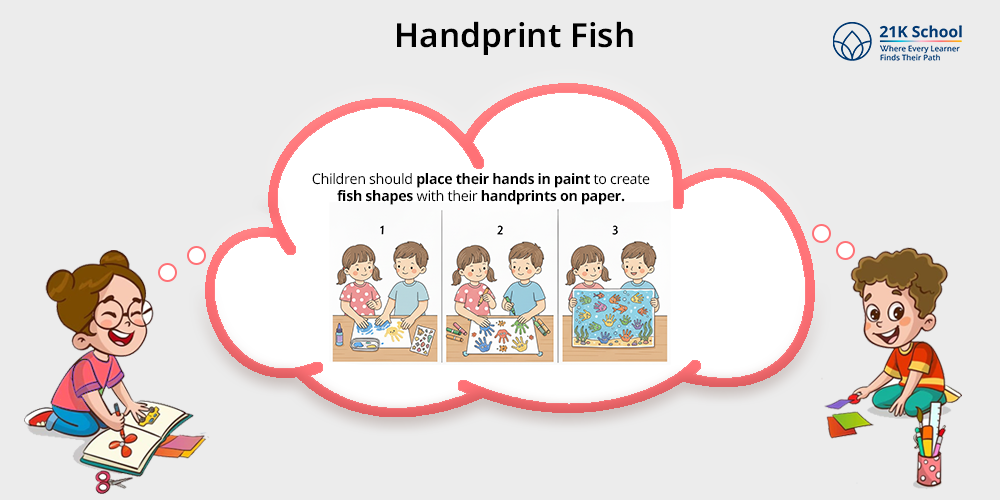
Children should place their hands in paint to create fish shapes with their handprints on paper. The complete ocean scene can be achieved by adding bubble patterns , seaweed, and other underwater elements.
The activity provides wonderful sensory experiences while resulting in appealing memorabilia.
- Creative Kit: Paint, pebbles, glue, decorative shrubs, colored paper, etc.
- Steps to Create: Paint your hands perfectly and press it on the paper or cardboard. Now, go on drawing the eyes of the fish and bubbles around it. Add small decorative shrubs and pebbles for a 3D effect.
- Quick Artist Tip: Add different colours of fishes with your hands to make it more compelling.
10. Sunflowers with Pens
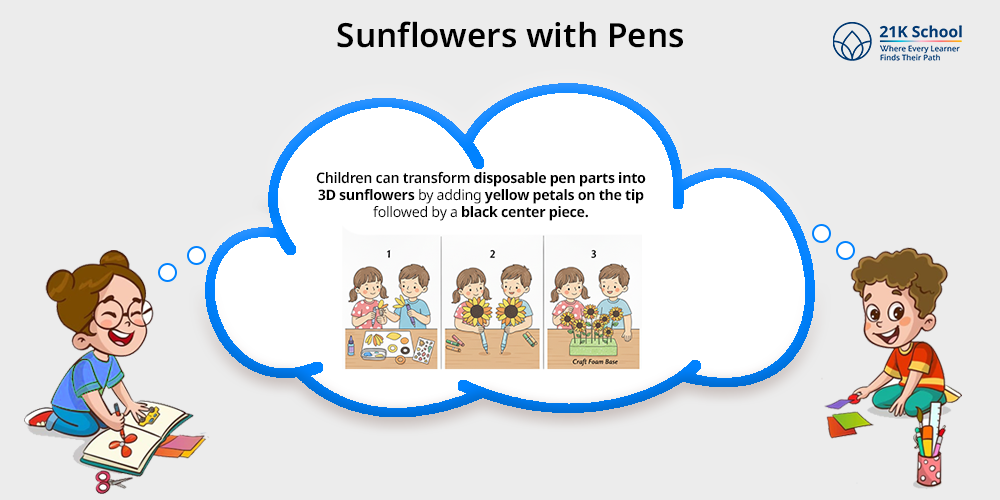
Children can transform disposable pen parts into 3D sunflowers by adding yellow petals on the tip followed by a black center piece. The small foam base serves as a platform for planting these pen creations.
This can be done to make them grow into a decorative pen garden. The activity unites fun and practical elements into a single combined creation.
- Creative Kit: Yellow and brown papers, markers, paints, pens, scissors, glue, etc.
- Steps to Create: Try cutting out petals of sunflowers and the centre part of it with yellow and brown papers respectively. Stick it on the top of the pens and color the pens with green paint
- Quick Artist Tip: Cut the petals such that its outer edges are longer to give it a bloomy and lively appearance.
What Are the Benefits of Creative Art and Craft in Kids?
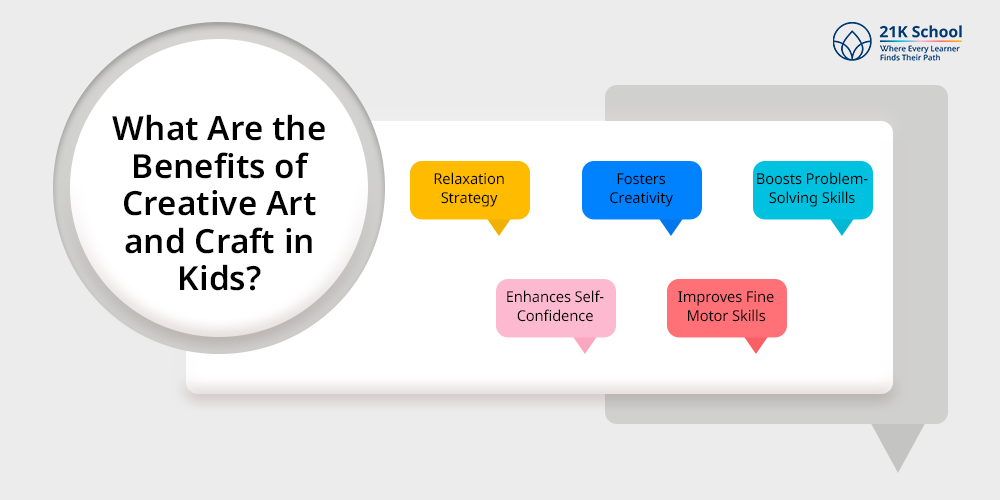
Children gain essential advantages from participating in artistic creation beyond simple classroom distraction. These activities enhance multiple developmental aspects that carry ways to promote lifelong learning .
1. Relaxation Strategy
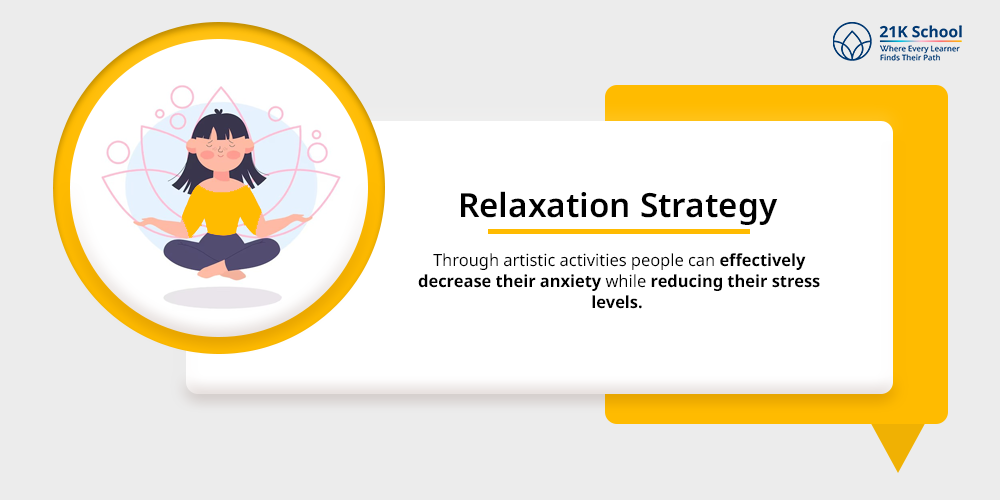
Through artistic activities people can effectively decrease their anxiety while reducing their stress levels. The recurring art activities between painting and crafting materials assists in practicing mindfulness in the classroom .
Art activities help children find rest while disconnecting from electronic devices and school work responsibilities.
2. Fosters Creativity
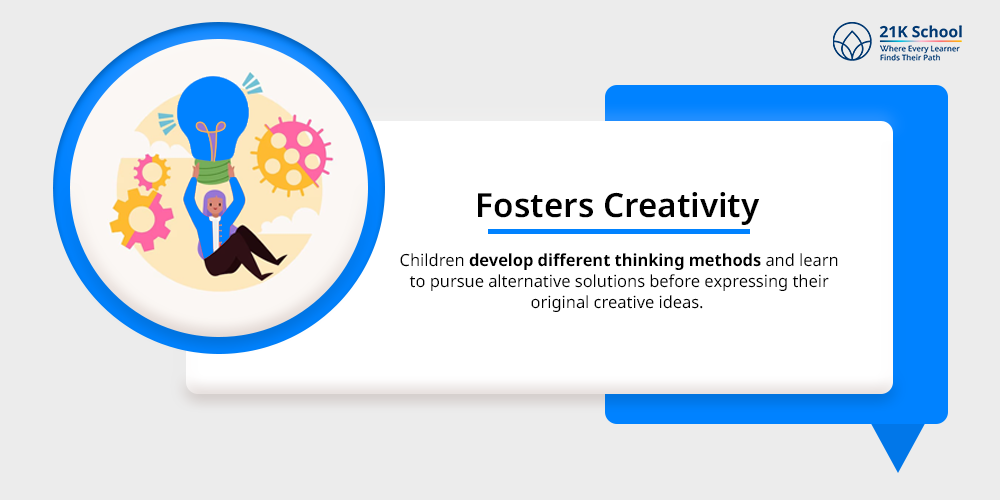
A creative playground exists where imagination finds its perfect home. Children develop different thinking methods and learn to pursue alternative solutions before expressing their original creative ideas.
A strong foundation of creativity emerges through art to push forward academic pursuits as well as non-academic domains.
3. Boosts Problem-Solving Skills
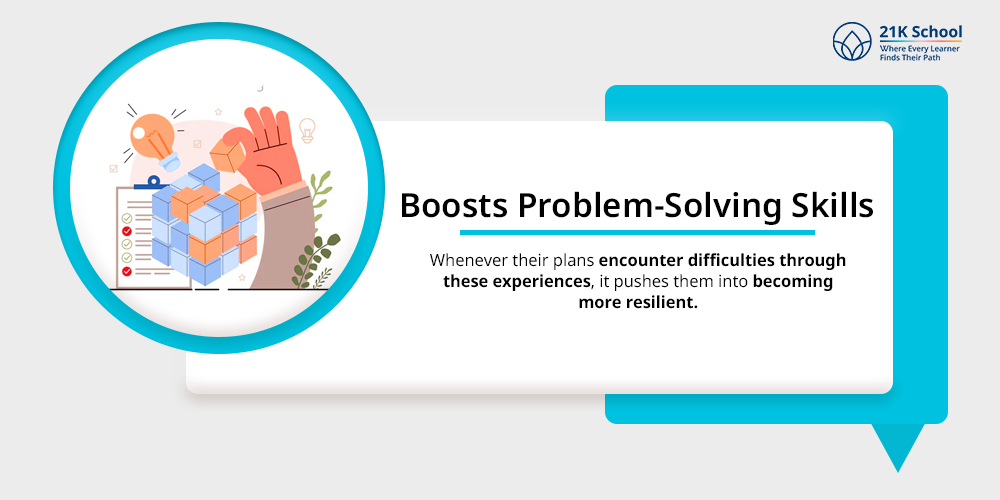
Children develop their ability to think logically and make decisions. Whenever their plans encounter difficulties through these experiences, it pushes them into becoming more resilient.
During the creative process people commonly need to try various approaches before reaching their goals. How do I make the stick stay? Using glue instead of tape during a project yields what results? These questions lead to cognitive development of children .
4. Enhances Self-Confidence
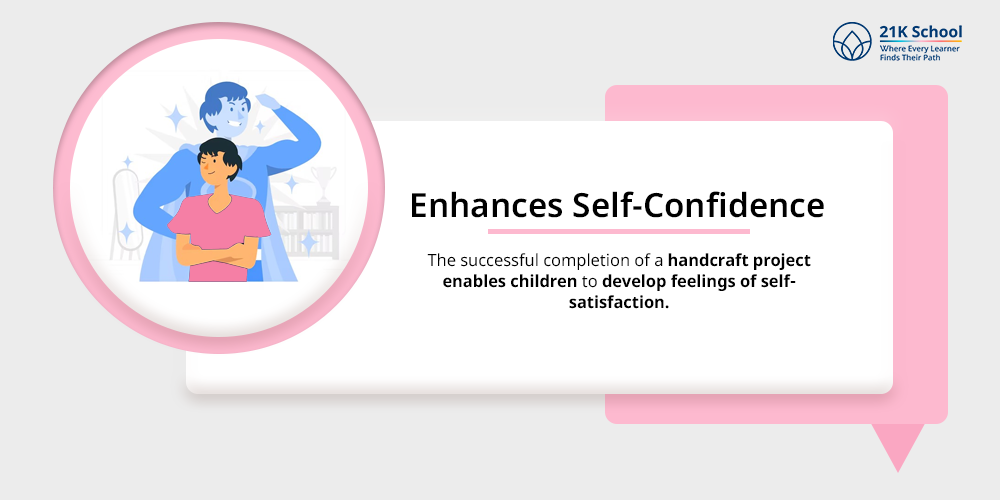
The successful completion of a handcraft project enables children to develop feelings of self-satisfaction. Organizing artwork display in classrooms or refrigerators lets students see their first hand work.
This small act of appreciation teaches the educators how to build confidence in children and provide pride in their achievements.
5. Improves Fine Motor Skills
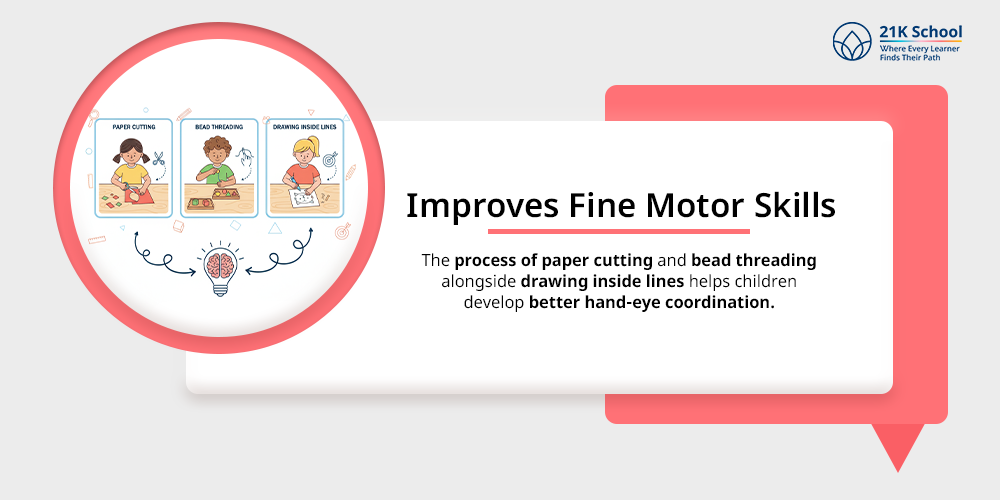
The process of paper cutting and bead threading alongside drawing inside lines helps children develop better hand-eye coordination. This assists them into building their fine motor skills.
Here are some of the other fine motor skills activities for your reference on better learning.
These life skills prove essential for daily composition, writing, as well as computer typing and standard activities.
Tips to Reinforce Creative Art and Craft in Kids
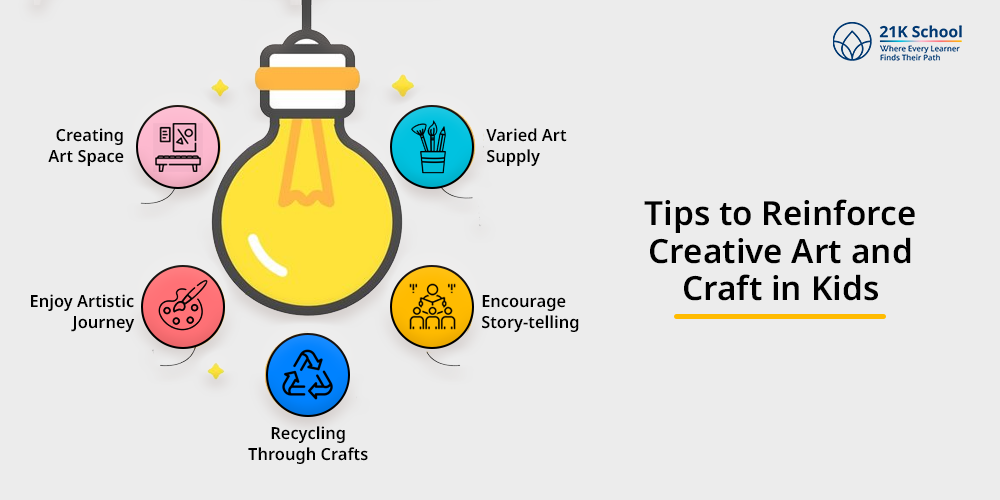
Knowing the numerous benefits of incorporating art and craft activities into child’s upbringing, let’s discuss some tips to encourage them:
- Creating Art Space: The establishment of an art space dedicated for creative activities regardless of its size will stimulate regular artistic pursuits in children.
- Enjoy Artistic Journey: Let your children be free from pursuing perfect results. However, they should concentrate on their artistic journey instead of their final product. Praise effort and imagination.
- Recycling Through Crafts: The use of recycled materials will transmit lessons about environmental responsibility while reducing both expenses and waste.
- Encourage Story-telling: Children should develop stories about their artwork to improve their cognitive development alongside linguistic abilities.
- Varied Art Supply: Art supply should vary frequently by introducing materials like beads, clay, fabric scraps, and colored paper to sustain creativity.
Key Takeaways
Children use art and craft activities to reorganize their thinking abilities and develop their ideas while maturing emotionally. The mixture of paint with glue and some natural elements enables children to study themselves and their environment.
When parents support creativity during child development their children grow into persistent innovators. They develop into someone who remains emotionally aware throughout life and develops lasting interests in learning
In current times speed and structure are emphasized. Therefore, art allows people to discover the simultaneous pleasure of self-expression and emotional calmness.
Provide children with paints for coloring their personal and professional lives. This will lead to an opportunity for their minds to achieve independent development.

